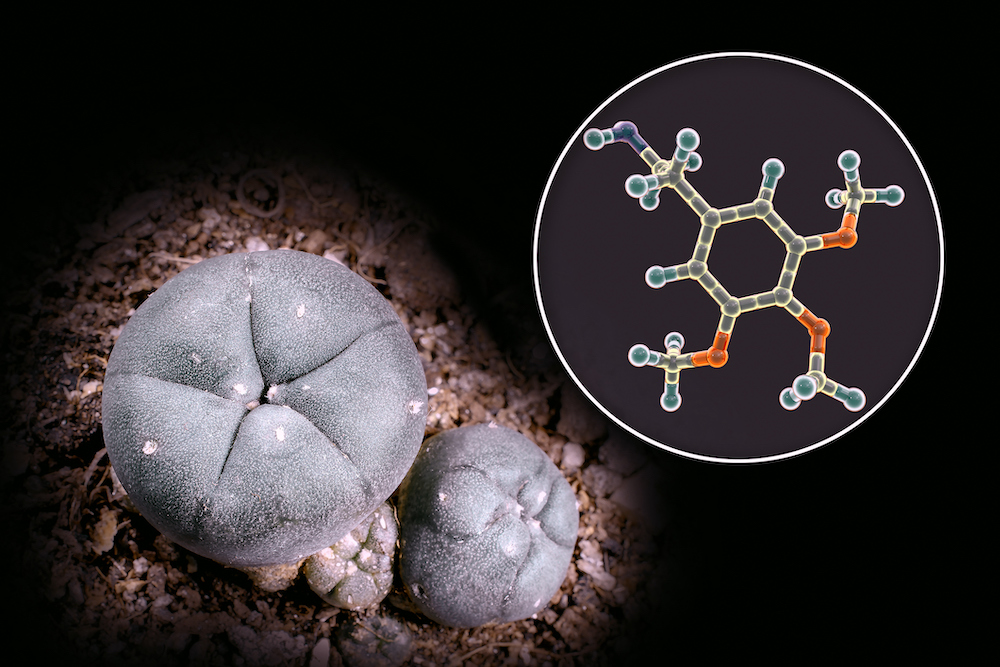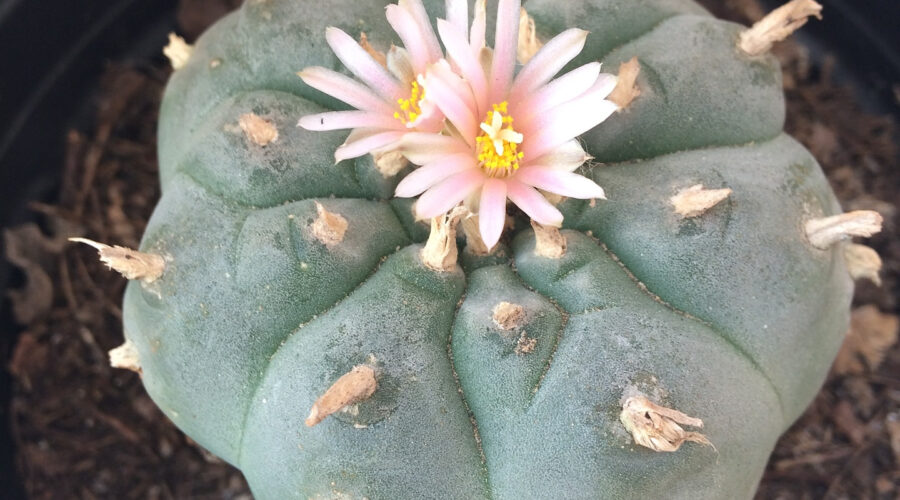What Are Peyote Buttons?
Peyote is a mescaline-containing cactus that has a rich history of use in North America. When people use peyote, they do so by consuming “peyote buttons”. In this article, we describe what peyote buttons are, exploring what they look like, the alkaloids they contain, their history of use, their effects, and how they work.
RELATED: San Pedro Cactus (Echinopsis Pachanoi) – Uses, Legality And More
A Brief Description Of Peyote Buttons

Peyote buttons take a long time to grow: 10-30 years for the plant to reach maturity. These buttons have pink to white flowers in summer, which bear elongated, pink edible fruits the following year.
Peyote buttons contain the psychedelic compound mescaline, as well as at least 28 other alkaloids, including the following.
- Tyramine
- N-methyltyramine
- Hordenine
- Anhalamine
- Anhalonidine
- Pellotine
- Lophophorine
Mescaline is found in the highest concentrations, this being the main psychoactive alkaloid in the plant. The mescaline content of dried buttons is 3-6 percent. Most of the other alkaloids in the peyote cactus are not psychoactive but some have some mild psychoactive effects, such as pellotine (the second most abundant compound in the plant). Pellotine can have some sedative and hypnotic effects, decreasing your desire to move and making you feel drowsy.
Many people who have used both synthetic/extracted mescaline and peyote find that the latter has some noticeably different effects. This could be due to the presence of several other alkaloids.
The History Of Peyote Buttons
Peyote buttons have a long history of use. Two archaeological specimens of dried peyote buttons have been discovered in Shumla Cave No. 5 on the Rio Grande, Texas, dating to 3780-3660 BC. The researchers who chemically analyzed these buttons found that they have a mescaline concentration of 2 percent. No other alkaloids were detected.
Here it should be underscored how close 2 percent is to the mescaline content of dried peyote buttons today. Also, many people take dried peyote buttons today that will have a mescaline concentration of around 2 percent. The fact that 5,700-year-old peyote buttons still had this level of concentration goes to show just how stable mescaline is. The absence of other alkaloids, meanwhile, indicates that some of the other compounds in the plant are more unstable.
The authors of the research on these archaeological specimens state the below.
“The two peyote samples appear to be the oldest plant drug ever to yield a major bioactive compound upon chemical analysis. The identification of mescaline strengthens the evidence that native North Americans recognized the psychotropic properties of peyote as long as 5700 years ago.”
We also have evidence of peyote use amongst the Aztec people. Spanish missionaries who visited Mexico in the 1500s observed the indigenous people there engaging in peyote rituals. However, these missionaries viewed the effects of peyote in a negative light. Native users of peyote were persecuted as a result. Religious opposition to peyote use from the Spanish missionaries eventually led to such use being prohibited throughout Mexico in 1720.
The Western World Even Has A Long History Of Using Peyote
Western scientists obtained — and experimented with — peyote buttons at the end of the 19th century, including Weir Mitchell and Havelock Ellis. Both documented their visually impressive experiences.
Peyote use is central to the Native American Church (NAC), a religion also known as Peyotism and Peyote Religion. This religion combines traditional Native American beliefs and Christianity, with peyote featuring as its religious sacrament. The religion originated in the late 19th century after peyote was introduced to the southern Great Plains from Mexico.
The United States government outlawed peyote, among many other psychedelics, with its Controlled Substances Act of 1970. This made peyote buttons a Schedule I drug, which, under the eyes of the law, meant they had no medical value and a high potential for abuse. However, the Indian Religious Freedom Act of 1978 was passed to provide legal protection for NAC members to use peyote.
Consider Using San Pedro Instead of Peyote
Peyote is the sacrament of indigenous tribes. So it’s like the communion wine of the Catholics. And so many indigenous people ask folks who aren’t Indigenous not to eat peyote. Eating peyote, they say, is like a non-Catholic drinking communion wine.
Indigenous people especially discourage eating peyote that is harvested from the wild. Naturally-grown peyote is in short supply. It takes so long to grow. So harvesting it further threatens the peyote supply, which is so important to the Indigenous.
In fact, many people are taking legal steps to protect peyote from use by non-Indigenous people. For example: many cities, states and counties are decriminalizing or legalizing naturally-occurring psychedelics. These laws often legalize mescaline-containing cactus. Yet they often exclude peyote from the list of cactuses you can legally grow. The writers of the laws are trying to listen to the wishes of indigenous tribes.
If you’d like to feel the effects of mescaline-containing cactus, think about using San Pedro instead of peyote. We have a guide to San Pedro that can help you. San Pedro has a lot of advantages over peyote. San Pedro is not illegal in the United States. Gardening shops tend to sell San Pedro. San Pedro grows quickly. There’s no shortage of San Pedro and there likely never will be.
However: if you’ve grown the peyote yourself, and you don’t believe there will be any harm in eating it, we have a guide here to help you.
Most people take peyote buttons after they have been dried. Once dried, you can chew them as they are. You should note, however, that the buttons have a strong bitter taste to them. This can make chewing them difficult.
Another option is to boil the dried buttons in water to produce peyote tea. One more alternative is to grind up the buttons into a powder and mix this into a juice to cover up the taste.
Since peyote buttons can cause uncomfortable nausea during the onset, experts recommend chewing them (or drinking your peyote beverage) slowly over a period of an hour or so. It’s also best to consume peyote buttons on an empty stomach. Both of these techniques can help to reduce the level of nausea you may experience.
It’s also perfectly normal to vomit after consuming peyote buttons. Typically, after you vomit, you’ll feel much better and the effects will intensify.
When consuming peyote buttons, your body will start digesting the plant material. When this happens, it is common to experience nausea, occurring within 30 minutes of ingesting the plant. The peyote gets digested by the stomach and travels through the intestinal tract, where the mescaline is rapidly absorbed. The mescaline then gets processed through the pancreas, liver, kidneys, and spleen, after which it binds to various receptors in the brain.
Mescaline — along with other classic psychedelics like LSD, psilocybin, and DMT — is a serotonergic psychedelic. This means it acts on the serotonin receptors in the brain. Like the other serotonergic psychedelics, mescaline induces psychedelic effects by binding to the serotonin 5-HT2A receptor.
However, mescaline also stimulates dopamine receptors and the serotonin 5-HT2C receptors. Scientists have observed that mescaline’s effects depend upon the stimulation of both the serotonin and dopamine receptors. Mescaline affects brain receptors differently from tryptamine psychedelics like psilocybin because it is a phenethylamine psychedelic.
Another example of a drug that belongs to the latter category is MDMA, which also causes a surge in dopamine. In fact, many people find mescaline is comparable to MDMA in many ways, especially in terms of the physical euphoria and increase in empathy it causes.
When mescaline binds to these different receptors, an experience can range from perceptual, emotional, spiritual, and physical effects. For many people, the peyote experience is incredibly healing and transformative.
As with other psychedelics, peyote buttons can induce a range of physical, perceptual, emotional, psychological, and spiritual effects. But since mescaline is in the phenethylamine family of psychedelics, the effects can be different in character to, say, psilocybin, which is in the tryptamine class.
Physical Effects
– Increased stimulation
– Physical euphoria
– Pupil dilation
– Increased heart rate
– Nausea
– Vomiting
Perceptual Effects
– Changes to visual, auditory, tactile, and taste perceptions
– Visual hallucinations (e.g. seeing geometric patterns)
– Visions (seeing scenes play out)
Emotional Effects
– Euphoria
– Joy
– Bliss
– Ecstasy
– Contentment
– Peacefulness
– Gratitude
– Empathy
– Compassion
– Fear
– Anxiety
– Confusion
– Dread
– Panic
– Despair
Psychological Effects
– Gaining new perspectives
– Reinterpreting aspects of one’s life
– Increased self-confidence
– Increased self-esteem
Spiritual Effects
– Ego loss
– A sense of existing outside of space and time
– A sense of the sacred or “divine” Ineffability
– A feeling of unity, marked by a dissolution of the boundary between yourself and the world
– The feeling of understanding or experiencing ultimate reality
– Paradoxical experiences (e.g. the feeling of being nothing and everything at the same time)




Christopher Smith
December 14, 2022 at 1:51 amThank you for writing this article. It was also very informative as well as easy to read.
Gregory
October 3, 2023 at 1:15 amPlease help me, im in the blue ridge mountains… need relief from PTS, anxiety disorder..I’m 64 need help thx!!